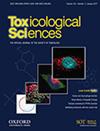House Dust-Derived Mixtures of Organophosphate Esters Alter the Phenotype, Function, Transcriptome, and Lipidome of KGN Human Ovarian Granulosa Cells
IF 4.1
3区 医学
Q2 TOXICOLOGY
引用次数: 0
Abstract
Organophosphate esters (OPEs), used as flame retardants and plasticizers, are present ubiquitously in the environment. Previous studies suggest that exposure to OPEs is detrimental to female fertility in humans. However, no experimental information is available on the effects of OPE mixtures on ovarian granulosa cells, which play essential roles in female reproduction. We used high-content imaging to investigate the effects of environmentally relevant OPE mixtures on KGN human granulosa cell phenotypes. Perturbations to steroidogenesis were assessed using ELISA and qRT-PCR. A high-throughput transcriptomic approach, TempO-Seq™, was used to identify transcriptional changes in a targeted panel of genes. Effects on lipid homeostasis were explored using a cholesterol assay and global lipidomic profiling. OPE mixtures altered multiple phenotypic features of KGN cells, with triaryl OPEs in the mixture showing higher potencies than other mixture components. The mixtures increased basal production of steroid hormones; this was mediated by significant changes in the expression of critical transcripts involved in steroidogenesis. Further, the total-OPE mixture disrupted cholesterol homeostasis and the composition of intracellular lipid droplets. Exposure to complex mixtures of OPEs, similar to those found in house dust, may adversely affect female reproductive health by altering a multitude of phenotypic and functional endpoints in granulosa cells. This study provides novel insights into the mechanisms of actions underlying the toxicity induced by OPEs and highlights the need to examine the effects of human relevant chemical mixtures.家庭灰尘产生的有机磷酸酯混合物改变了 KGN 人类卵巢颗粒细胞的表型、功能、转录组和脂质组
作为阻燃剂和增塑剂使用的有机磷酸酯(OPEs)在环境中无处不在。以往的研究表明,接触 OPE 会损害人类女性的生育能力。然而,目前还没有关于 OPE 混合物对卵巢颗粒细胞影响的实验资料,而颗粒细胞在女性生殖过程中发挥着至关重要的作用。我们利用高含量成像技术研究了环境相关 OPE 混合物对 KGN 人类颗粒细胞表型的影响。使用 ELISA 和 qRT-PCR 评估了对类固醇生成的干扰。高通量转录组学方法 TempO-Seq™ 被用来确定目标基因组的转录变化。利用胆固醇测定和全球脂质组分析探讨了对脂质稳态的影响。OPE 混合物改变了 KGN 细胞的多种表型特征,混合物中的三芳基 OPE 比其他混合物成分显示出更高的效力。混合物增加了类固醇激素的基础生成;这是通过参与类固醇生成的关键转录本的表达发生显著变化来实现的。此外,OPE 总混合物破坏了胆固醇的平衡和细胞内脂滴的组成。暴露于复杂的 OPE 混合物(类似于在室内灰尘中发现的 OPE 混合物)可能会改变颗粒细胞的多种表型和功能终点,从而对女性生殖健康产生不利影响。这项研究为了解 OPE 诱发毒性的作用机制提供了新的视角,并强调了研究与人类相关的化学混合物影响的必要性。
本文章由计算机程序翻译,如有差异,请以英文原文为准。
求助全文
约1分钟内获得全文
求助全文
来源期刊

Toxicological Sciences
医学-毒理学
CiteScore
7.70
自引率
7.90%
发文量
118
审稿时长
1.5 months
期刊介绍:
The mission of Toxicological Sciences, the official journal of the Society of Toxicology, is to publish a broad spectrum of impactful research in the field of toxicology.
The primary focus of Toxicological Sciences is on original research articles. The journal also provides expert insight via contemporary and systematic reviews, as well as forum articles and editorial content that addresses important topics in the field.
The scope of Toxicological Sciences is focused on a broad spectrum of impactful toxicological research that will advance the multidisciplinary field of toxicology ranging from basic research to model development and application, and decision making. Submissions will include diverse technologies and approaches including, but not limited to: bioinformatics and computational biology, biochemistry, exposure science, histopathology, mass spectrometry, molecular biology, population-based sciences, tissue and cell-based systems, and whole-animal studies. Integrative approaches that combine realistic exposure scenarios with impactful analyses that move the field forward are encouraged.
 求助内容:
求助内容: 应助结果提醒方式:
应助结果提醒方式:


